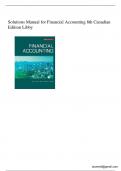stumerit@gmail.com Solutions Manual for Financial Accounting 8th Canadian Edition Libby stumerit@gmail.com Chapter 01 - Financial Statements and Business Decisions Chapter 1 Financial Statements and Business Decisions ANSWERS TO QUESTIONS 1. Accounting is a system that collects and processes (analyzes, measures, and records) financial information about an organization and reports that information to decision makers. 2. Financial accounting involves preparation of the four basic financial statements and related disclosures for external decision makers. Managerial accounting involves the preparation of detailed plans, budgets, forecasts, and performance reports for internal decision makers. 3. Financial reports are used by both internal and external groups and individuals. The internal groups are comprised of the various managers of the entity. The external groups include the owners, investors, creditors, governmental agencies, other interested parties, and the public at large. 4. Investors purchase all or part of a business and hope to gain by receiving part of what the company earns and/or selling the company in the future at a higher price than they paid. Creditors lend money to a company for a specific length of time and hope to gain by charging interest on the loan. 5. In a society each organization can be defined as a separate accounting entity. An accounting entity is the organization for which financial data are to be collected. Typical accounting entities are a business, a church, a governmental unit, a university and other nonprofit organizations such as a hospital and a welfare organization. A business typically is defined and treated as a separate entity because the owners, creditors, investors, and other interested parties need to evaluate its performance and its potential separately from other entities and from its owners. 6. Name of Statement Alternative Title (a) Income Statement (a) Statement of Earnings; Statement of Income; Statement of Operations (b) Balance Sheet (b) Statement of Financial Position (c) Audit Report (c) Report of Independent Accountants stumerit@gmail.com Financial Accounting, 8/e 1-1 © 2014 by McGraw -Hill Global Education Holdings, LLC. This is proprietary material solely for authorized instructor use. Not authorized for sale or distribution in any manner. This document may not be copied, scanned, duplicated, forwarded, distributed, or posted on a website, in whole or part. stumerit@gmail.com 7. The heading of each of the four required financial statements should include the following: (a) Name of the entity (b) Name of the statement (c) Date of the statement, or the period of time (d) Unit of measure 8. (a) The purpose of the income statement is to present information about the revenues, expenses, and the net income of the entity for a specified period of time. (b) The purpose of the balance sheet is to report the financial position of an entity at a given date, that is, to report information about the assets, obligations and stockholders’ equity of the entity as of a specific date. (c) The purpose of the statement of cash flows is to present information about the flow of cash into the entity (sources), the flow of cash out of the entity (uses), and the net increase or decrease in cash during the period. (d) The statement of stockholders’ equity reports the changes in each of the company’s stockholders’ equity accounts during the accounting period including issue and repurchase of stock and the way that net income and distribution of dividends affected the retained earnings of the company during that period. 9. The income statement and the statement of cash flows are dated ―For the Year Ended December 31, 2013,‖ because they report the inflows and outflows of resources during a period of time. In contrast, the balance sheet is dated ―At December 31, 2013,‖ because it represents the resources, obligations and stockholders’ equity at a specific date. 10. Assets are important to creditors and investors because assets provide a basis for judging whether sufficient resources are available to operate the company. Assets are also important because they could be sold for cash in the event the company goes out of business. Liabilities are important to creditors and investors because the company must be able to generate sufficient cash from operations or further borrowing to meet the payments required by debt agreements. If a business does not pay its creditors, the law may give the creditors the right to force the sale of assets sufficient to meet their claims. 11. Net income is the excess of total revenues over total expenses. Net loss is the excess of total expenses over total revenues. 12. The equation for the income statement is Revenues - Expenses = Net Income (or Net Loss if the amount is negative). Thus, the three major items reported on the income statement are (1) revenues, (2) expenses, and (3) net income. 1-2 Solutions Manual © 2014 by McGraw -Hill Global Education Holdings, LLC. This is proprietary material solely for authorized instructor use. Not authorized for sale or distribution in any manner. This document may not be copied, scanned, duplicated, forwarded, distributed, or posted on a website, in whole or part.




